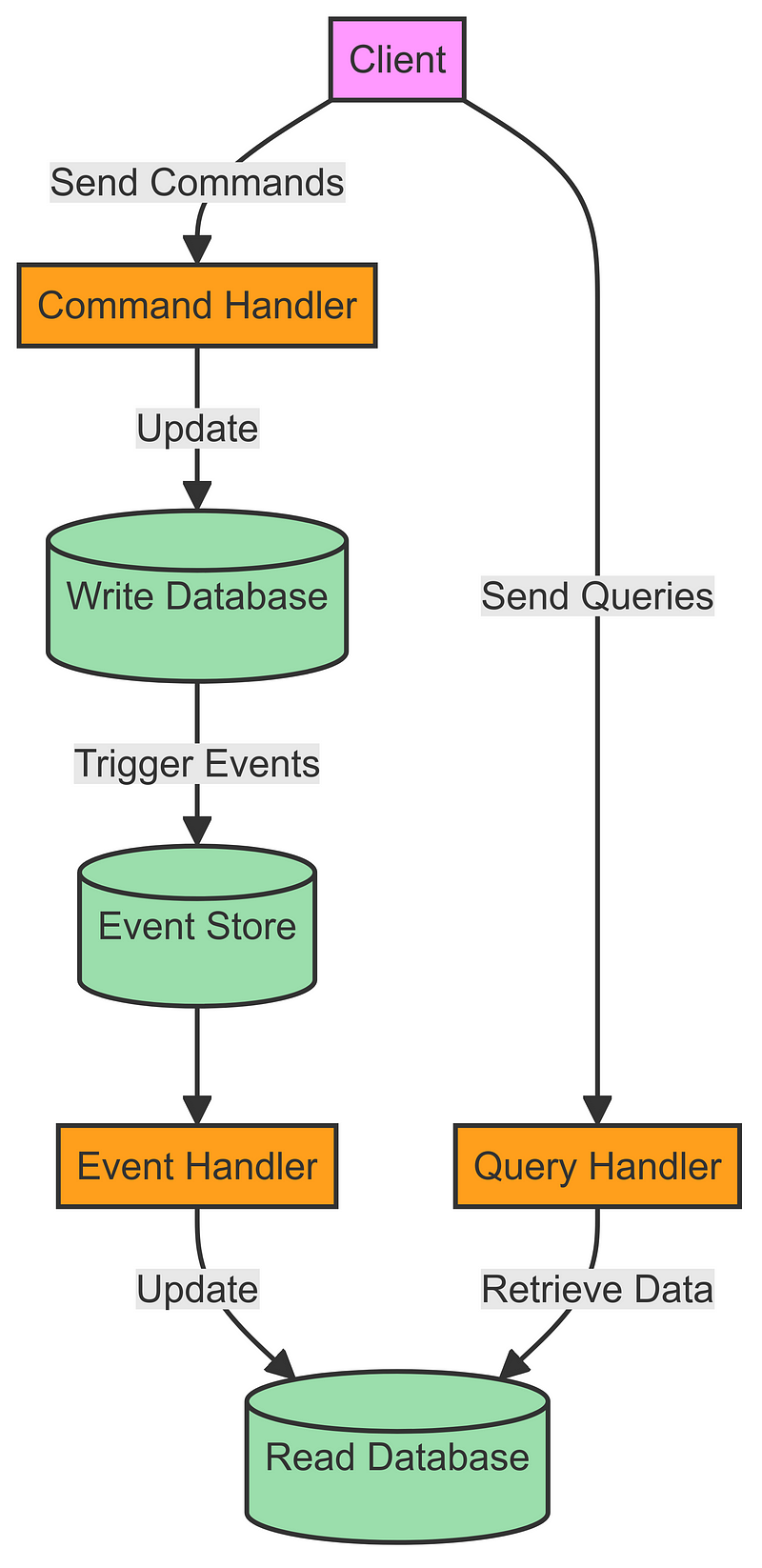Implementing CQRS and Event Sourcing in Distributed Systems
 Mahidhar Mullapudi
Mahidhar MullapudiTable of contents
- Introduction
- Understanding CQRS
- What is CQRS?
- Benefits of CQRS
- Key Concepts in CQRS
- Introduction to Event Sourcing
- What is Event Sourcing?
- Benefits of Event Sourcing
- Key Concepts in Event Sourcing
- Combining CQRS and Event Sourcing
- The Synergy Between CQRS and Event Sourcing
- Architecture Overview
- Use Case: E-commerce Order Management
- Why Choose E-commerce?
- Features of the Order Management System
- Implementation with Java and Spring Boot
- Setting Up the Project
- Command Model: Handling Write Operations
- Explanation of Keywords
- Event Store: Persisting Events
- Explanation of Keywords
- Read Model: Building Optimized Views
- Explanation of Keywords
- Client-Side Implementation
- Explanation of Keywords
- Testing and Debugging
- Testing CQRS and Event Sourcing
- Debugging Tips
- Conclusion
Introduction
As software systems grow in complexity, the need for scalable and maintainable architectures becomes paramount. Two powerful patterns that address these needs are Command Query Responsibility Segregation (CQRS) and Event Sourcing. By leveraging these patterns, along with reactive principles, you can build systems that are highly responsive, resilient, and flexible. In this article, we will explore the concepts of CQRS and Event Sourcing, and provide detailed examples of how to implement them in a distributed system using Java and Spring Boot.
Understanding CQRS
What is CQRS?
CQRS stands for Command Query Responsibility Segregation. It is a design pattern that separates the operations of reading data (queries) from the operations of modifying data (commands). This separation allows for more optimized and scalable solutions, as each operation can be handled differently and optimized independently.
Benefits of CQRS
Scalability: Separating reads and writes allows each to be scaled independently, improving overall system performance.
Optimized Performance: Queries can be optimized for read performance, while commands can be optimized for write performance.
Simplified Complexities: By separating responsibilities, the complexities of each operation type are reduced.
Key Concepts in CQRS
Commands: Represent operations that change the state of the application. Examples include creating, updating, or deleting records.
Queries: Represent operations that read the state of the application without modifying it. Examples include fetching records or aggregating data.

Command Query Responsibility Segregation (CQRS) pattern
Introduction to Event Sourcing
What is Event Sourcing?
Event Sourcing is a pattern where state changes in an application are stored as a sequence of events. Instead of storing just the current state, all changes are captured and stored, allowing the system to reconstruct any past state by replaying the events.
Benefits of Event Sourcing
Auditability: Complete history of changes is maintained, providing a full audit trail.
Reproducibility: Any past state can be reconstructed by replaying the sequence of events.
Scalability: Event logs can be partitioned and processed independently, improving scalability.
Key Concepts in Event Sourcing
Events: Represent state changes that have occurred in the system. Examples include order placed, payment received, or item shipped.
Event Store: A storage system that captures and persists events. It acts as the single source of truth for the application’s state.

Event Sourcing pattern
Combining CQRS and Event Sourcing
The Synergy Between CQRS and Event Sourcing
Combining CQRS with Event Sourcing provides a powerful architecture for building distributed systems. CQRS allows for separate optimization of read and write operations, while Event Sourcing ensures a complete history of state changes. Together, they enable systems that are scalable, maintainable, and resilient.
Architecture Overview
Command Model: Handles write operations and generates events.
Event Store: Persists events generated by the command model.
Read Model: Builds optimized views for query operations by subscribing to events.
Use Case: E-commerce Order Management
Why Choose E-commerce?
E-commerce systems require handling a large number of transactions and maintaining a comprehensive history of operations. Implementing CQRS and Event Sourcing in an e-commerce order management system can showcase the benefits of these patterns in a real-world scenario.
Features of the Order Management System
Handling orders, payments, and shipments.
Maintaining a complete history of all operations.
Providing optimized views for order queries.
Implementation with Java and Spring Boot
Setting Up the Project
- Create a Spring Boot Project: Use Spring Initializr to create a new Spring Boot project with the necessary dependencies.
spring init --dependencies=data-jpa,web,actuator e-commerce-system
- Project Structure:
├── src
│ ├── main
│ │ ├── java
│ │ │ └── com.example.ecommerce
│ │ │ ├── EcommerceApplication.java
│ │ │ ├── config
│ │ │ │ └── EventStoreConfig.java
│ │ │ ├── controller
│ │ │ │ └── OrderController.java
│ │ │ ├── model
│ │ │ │ ├── Order.java
│ │ │ │ ├── OrderEvent.java
│ │ │ │ └── OrderStatus.java
│ │ │ ├── repository
│ │ │ │ ├── OrderRepository.java
│ │ │ │ └── EventStoreRepository.java
│ │ │ ├── service
│ │ │ │ ├── OrderService.java
│ │ │ │ └── EventStoreService.java
│ │ │ └── event
│ │ │ ├── OrderCreatedEvent.java
│ │ │ ├── OrderPaidEvent.java
│ │ │ └── OrderShippedEvent.java
│ │ ├── resources
│ │ │ └── application.properties
Command Model: Handling Write Operations
Implement the command model to handle write operations and generate events.
package com.example.ecommerce.service;
import com.example.ecommerce.model.Order;
import com.example.ecommerce.model.OrderStatus;
import com.example.ecommerce.event.OrderCreatedEvent;
import com.example.ecommerce.repository.OrderRepository;
import com.example.ecommerce.repository.EventStoreRepository;
import org.springframework.stereotype.Service;
import org.springframework.transaction.annotation.Transactional;
@Service
public class OrderService {
private final OrderRepository orderRepository;
private final EventStoreRepository eventStoreRepository;
public OrderService(OrderRepository orderRepository, EventStoreRepository eventStoreRepository) {
this.orderRepository = orderRepository;
this.eventStoreRepository = eventStoreRepository;
}
@Transactional
public void createOrder(Order order) {
order.setStatus(OrderStatus.CREATED);
orderRepository.save(order);
OrderCreatedEvent event = new OrderCreatedEvent(order.getId(), order.getTotal());
eventStoreRepository.save(event);
}
@Transactional
public void payOrder(Long orderId) {
Order order = orderRepository.findById(orderId).orElseThrow();
order.setStatus(OrderStatus.PAID);
orderRepository.save(order);
OrderPaidEvent event = new OrderPaidEvent(orderId);
eventStoreRepository.save(event);
}
@Transactional
public void shipOrder(Long orderId) {
Order order = orderRepository.findById(orderId).orElseThrow();
order.setStatus(OrderStatus.SHIPPED);
orderRepository.save(order);
OrderShippedEvent event = new OrderShippedEvent(orderId);
eventStoreRepository.save(event);
}
}
Explanation of Keywords
@Service: Indicates that the class is a service component in the Spring framework.
@Transactional: Indicates that the method should be executed within a transactional context.
OrderCreatedEvent: Event representing the creation of an order.
OrderPaidEvent: Event representing the payment of an order.
OrderShippedEvent: Event representing the shipment of an order.
Event Store: Persisting Events
Configure an event store to persist events generated by the command model.
package com.example.ecommerce.repository;
import com.example.ecommerce.event.OrderEvent;
import org.springframework.data.jpa.repository.JpaRepository;
public interface EventStoreRepository extends JpaRepository<OrderEvent, Long> {
}
Explanation of Keywords
- JpaRepository: A JPA-specific extension of the Repository interface that provides JPA related methods for standard CRUD operations.
Read Model: Building Optimized Views
Implement the read model to build optimized views for query operations by subscribing to events.
package com.example.ecommerce.service;
import com.example.ecommerce.model.Order;
import com.example.ecommerce.repository.OrderRepository;
import com.example.ecommerce.event.OrderCreatedEvent;
import com.example.ecommerce.event.OrderPaidEvent;
import com.example.ecommerce.event.OrderShippedEvent;
import org.springframework.context.event.EventListener;
import org.springframework.stereotype.Service;
import java.util.List;
@Service
public class ReadModelService {
private final OrderRepository orderRepository;
public ReadModelService(OrderRepository orderRepository) {
this.orderRepository = orderRepository;
}
@EventListener
public void handleOrderCreated(OrderCreatedEvent event) {
Order order = new Order();
order.setId(event.getOrderId());
order.setTotal(event.getTotal());
order.setStatus(OrderStatus.CREATED);
orderRepository.save(order);
}
@EventListener
public void handleOrderPaid(OrderPaidEvent event) {
Order order = orderRepository.findById(event.getOrderId()).orElseThrow();
order.setStatus(OrderStatus.PAID);
orderRepository.save(order);
}
@EventListener
public void handleOrderShipped(OrderShippedEvent event) {
Order order = orderRepository.findById(event.getOrderId()).orElseThrow();
order.setStatus(OrderStatus.SHIPPED);
orderRepository.save(order);
}
public List<Order> getAllOrders() {
return orderRepository.findAll();
}
}
Explanation of Keywords
@EventListener: Indicates that the method should be invoked when an application event is published.
OrderCreatedEvent: Event representing the creation of an order.
OrderPaidEvent: Event representing the payment of an order.
OrderShippedEvent: Event representing the shipment of an order.
Client-Side Implementation
Implement a simple client-side interface to interact with the order management system.
<!DOCTYPE html>
<html>
<head>
<title>E-commerce Order Management</title>
<script>
async function createOrder() {
const response = await fetch('/orders', { method: 'POST', headers: { 'Content-Type': 'application/json' }, body: JSON.stringify({ total: 100 }) });
const order = await response.json();
displayOrder(order);
}
async function displayOrder(order) {
const orderElement = document.createElement('div');
orderElement.textContent = `Order ID: ${order.id}, Total: ${order.total}, Status: ${order.status}`;
document.getElementById('orders').appendChild(orderElement);
}
</script>
</head>
<body>
<h1>E-commerce Order Management</h1>
<button onclick="createOrder()">Create Order</button>
<div id="orders"></div>
</body>
</html>
Explanation of Keywords
fetch: A JavaScript function to make HTTP requests.
async/await: JavaScript syntax for handling asynchronous operations.
Testing and Debugging
Testing CQRS and Event Sourcing
Use integration tests to validate the command and read models.
Write unit tests to ensure events are correctly generated and handled.
Debugging Tips
Enable detailed logging for commands, events, and queries.
Use monitoring tools to track event flow and system performance.
Conclusion
In this article, we explored how to implement CQRS and Event Sourcing in a distributed system using Java and Spring Boot. We covered the essential concepts, set up a project, and implemented a real-world e-commerce order management system. By leveraging these patterns, you can build systems that are scalable, maintainable, and resilient. We encourage you to experiment with these technologies and explore additional features such as event replay, sagas, and eventual consistency.
Subscribe to my newsletter
Read articles from Mahidhar Mullapudi directly inside your inbox. Subscribe to the newsletter, and don't miss out.
Written by

Mahidhar Mullapudi
Mahidhar Mullapudi
Currently working as Senior Staff Engineer @Microsoft, I'm an expert in software architecture, system design, architectural patterns of a large-scale distributed products/services, cloud infrastructure and security. Proficient in different programming languages including Java, C#, Python with over a decade of experience working on applications at scale. Independent researcher with more than 20+ research articles across different fields in Computer Science with focus on Distributed systems, designing and building large-scale resilient applications, building real-time data platforms for analytics and Machine Learning. Founder and author of tutorialQ (https://tutorialq.com/) which provides quality technical content for learning programming, web development and other software related tech stack.